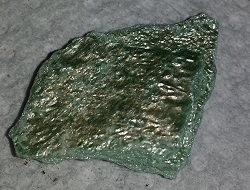A- |
B- |
C- |
D- |
E- |
F- |
G- |
H- |
I- |
J- |
K- |
L- |
M- |
N- |
O- |
P- |
Q- |
R- |
S- |
T- |
U- |
V- |
W- |
X- |
Y- |
Z |
FUCHSITE:PHYSICAL CHARACTERISTICS:Color is green, often a deep green with a hint of yellow. Luster is vitreous to pearly. Transparency crystals are transparent to translucent. Crystal System is monoclinic; 2/m Crystal Habits include tabular crystals with a prominent pinacoid termination. Fuchshite's four prism faces form diamond shaped "books" and if modified by another pinacoid they form pseudo-hexagonal crystal "books". The sides of the crystal often tend to tapper. Also as lamellar rock forming masses and small flakes in detrital material. Twinned crystals can form flat five pointed stars. Cleavage is perfect in one direction producing thin sheets or flakes. Fracture is not readily observed due to cleavage but is uneven. Hardness is 2 - 2.5. Specific Gravity is approximately 2.8 (average) Streak is white. Associated Minerals are quartz, feldspars, beryl and tourmalines. Other Characteristics: cleavage sheets are flexible and elastic, meaning they can be bent and will flex back to original shape. Notable Occurrences include Sweden, Austria, Brazil and many USA localities. Best Field Indicators are crystal habit, cleavage, elastic sheets, color and associations. Fuchsite is a dark green variety of muscovite. It can have a wonderfully dark emerald green color that can have a beautiful sparkly shine if the crystals are small. It is often found in compact masses with small crystals. The green color is the result of chromium impurities. |

